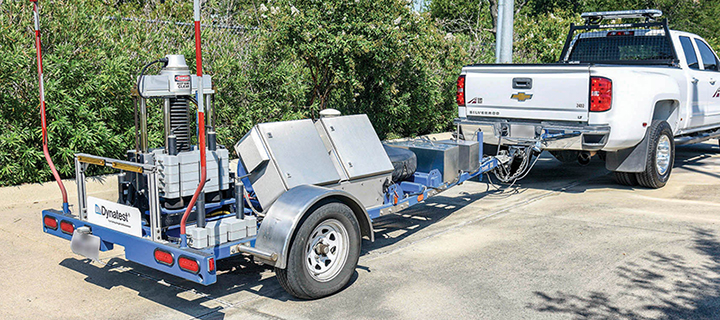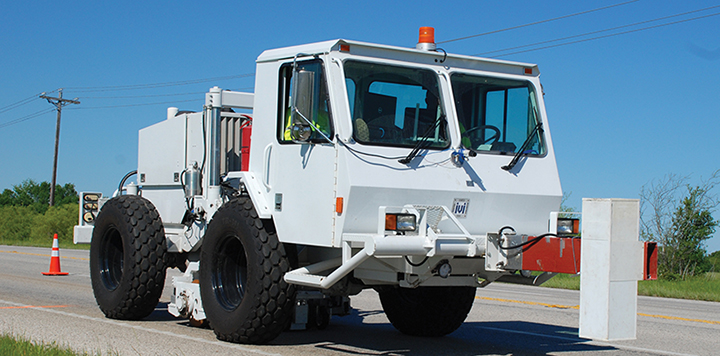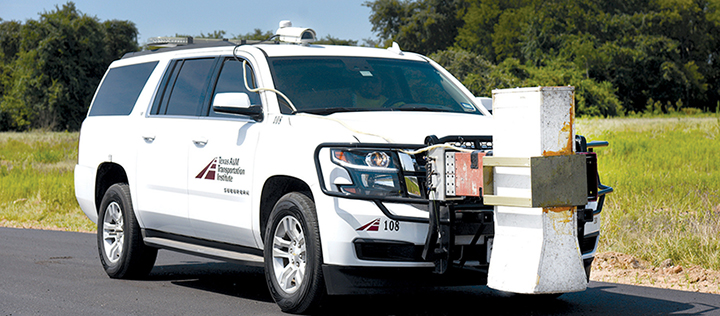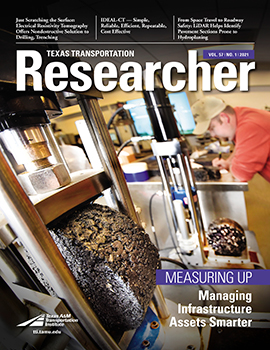
Tailoring construction and repair solutions to unique problems along a discrete part of the roadway — instead of applying a one-size-fits-all method — is gaining popularity as a pavement design/rehabilitation method for entire corridors. It’s just one innovation that Texas A&M Transportation Institute (TTI) researchers are using to help the Texas Department of Transportation (TxDOT) with its roadway maintenance projects across the Lone Star State. TTI’s comprehensive approach to pavement forensics is resulting in notable time and cost savings, and, in many cases, yielding environmental benefits associated with pavement reuse and recycling.
Nondestructive Testing Saves Resources for TxDOT Bryan District
Researchers recently completed testing and evaluation on a research case study for a TxDOT Bryan District pavement widening project on SH 6 from south College Station at SH 40 north to Bryan at US 190. Using a variety of pavement forensic evaluation tools, smart coring strategies, and traffic data analysis, the bulk of the work in this type of study happens before letting a project. The intention: to evaluate corridors for alternative rehabilitation methods that will accelerate construction.
“Our goal is to help the district find the most efficient use of resources,” says TTI Research Engineer Darlene Goehl, who leads the TxDOT research project.
Typically, the first step is to scan the entire corridor using ground-penetrating radar (GPR) and high-definition video to identify the general problem areas that show damage. Then, explains Goehl, “Based on the type of damage seen in that analysis, we can evaluate particular areas separately with other appropriate NDT [nondestructive testing] tools that help us determine what is causing the damage and exactly where coring should occur.”
In the SH 6 corridor, researchers used a falling-weight deflectometer (FWD) and a total pavement acceptance device (TPAD) to target areas to help determine that much of the main lane and frontage road pavement was in good structural condition. As a result, a complete reconstruction was not necessary. A mobile laser scanner — which uses LiDAR — was employed to evaluate the roadway geometry to determine whether to widen sections to the inside or outside. In one segment, the shoulder required an overlay with lanes widened to the outside. In another segment, the existing main lane pavement could be used as the subbase for new concrete pavement, requiring lanes to be widened to the inside.
Typical pavement strategies are to remove and replace all existing pavement. In this case study, TTI determined that the main lane removal was unnecessary, resulting in a savings of approximately $33.4 million and a time savings related to construction impacts for the traveling public of up to 19 months.
“TTI analyzed multiple options to accelerate construction and minimize the impact to the traveling public. Its research laid the foundation that minimized the amount of rehabilitation needed and focused on the most cost-efficient plan to construct the widening,” says TxDOT Bryan District Engineer James Robbins. “This research provided TxDOT the ability to sequence work to minimize the impact to daily traffic in areas of known congestion.”
Finding Best Rehab Solutions for TxDOT Beaumont District
Assessing the true condition of a pavement is rarely possible with the naked eye. But knowing what exactly has caused damage — and what’s in and underneath the pavement — is the key to finding the best rehabilitation solution. NDT equipment serves as the “eyes” that allow pavement engineers to literally look below the roadway’s surface to find the problem.
“Variability in the pavement structure and in the support of the subgrade soil for the pavement can be a real issue with rehabilitation,” says TTI Research Scientist Stephen Sebesta. “We use these NDT tools to strategically select coring and roadway sampling locations that cover the range of expected site conditions over the length of a corridor.” This approach leverages time and resources to validate the interpretations of the NDT done with GPR and FWD, and minimizes risks and surprises.
TTI used GPR to examine an approximately 0.8-mile portion of FM 1746 in the TxDOT Beaumont District. The GPR scan identified this localized section as having a different structural makeup than expected, clarifying its composition and providing direction for the rehabilitation needed. According to Sebesta, “This is a good example where we would go to different locations for further sampling/testing to verify and document what that variability is, and then, as appropriate, plan the best design accordingly.”
On this project, the FWD also measured a localized area of concern where a revised pavement strategy was needed. Capturing this variability up front and designing/planning for it ahead of time go a long way to ensuring a project’s success.
“TTI has been instrumental in our efforts to keep our ride scores up,” says John Sudela, TxDOT Beaumont District pavement engineer. “Its equipment, labs and expertise all play a role in the work we do to find the most effective and economical pavement designs and rehabilitation solutions.”



